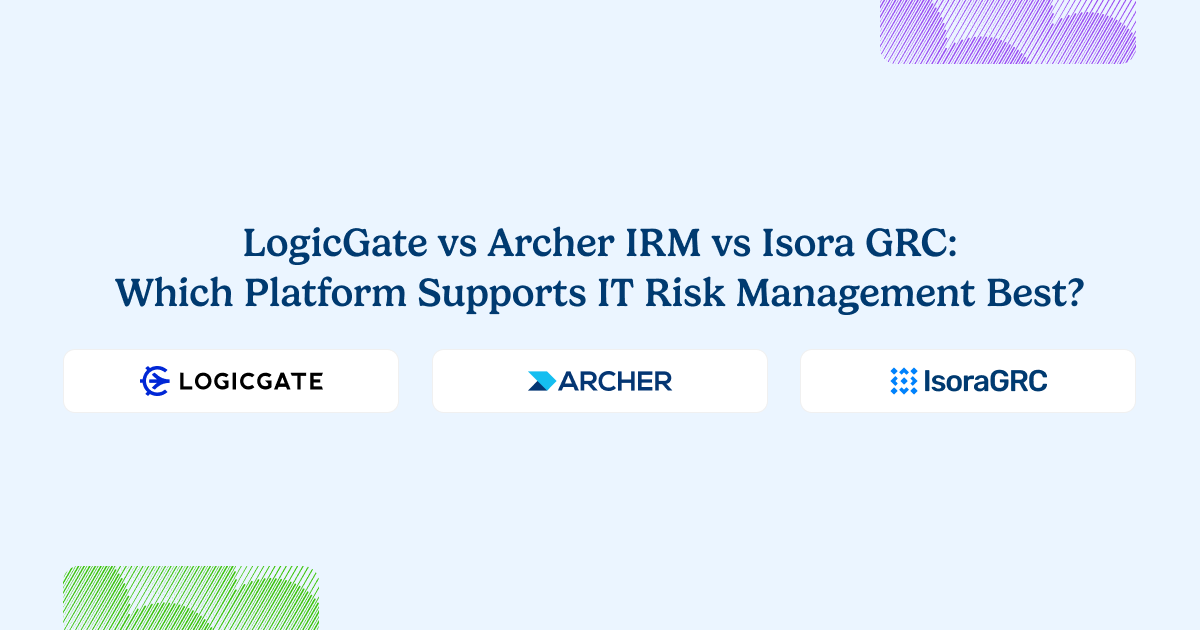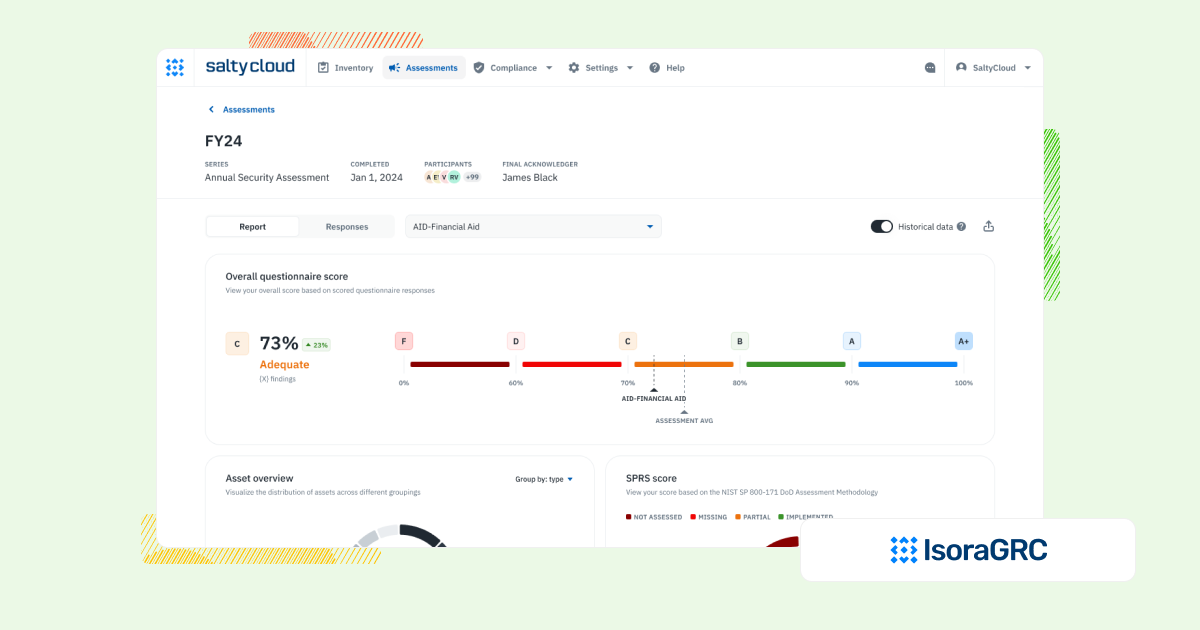
Every security team needs a straightforward, scalable way to manage IT risk without the clutter.
Platforms like LogicGate and Archer IRM offer broad GRC capabilities, designed to handle everything from compliance management to enterprise risk.
But when a platform tries to do everything, security teams are often left with too much complexity and not enough clarity. These systems can be slow to configure, difficult to adopt, and often fail to connect directly with the day-to-day needs of managing IT risk.
Isora GRC takes a more tailored route. It’s purpose-built for security teams who need to assess assets, track risks, and manage vendors, without getting lost in the complexity of broader GRC solutions.
Let’s take a deeper dive.
Choosing the Right Platform for IT Risk Management
LogicGate is known for its configurability, but that flexibility often comes at the cost of speed and usability. Archer IRM delivers extensive governance capabilities, but it’s complex and tailored more for GRC professionals than IT risk teams. Both platforms can support risk initiatives—but they typically require long implementations, heavy customization, and constant tuning.
Isora GRC is different. It offers structured, out-of-the-box workflows for risk assessments, inventories, vendor reviews, exception tracking, and risk registers. It’s fast to deploy, easy for teams to adopt, and designed specifically to support how security teams manage IT risk today.
The Workflow That Matters: Managing IT Risks and Compliance
Managing IT risk isn’t a quarterly project or a back-office exercise—it’s a continuous, collaborative process across teams, vendors, and systems. It demands clear workflows for gathering assessments, managing assets and vendors, documenting risks, and tracking exceptions as they arise.
Many GRC platforms weren’t built to support this type of dynamic, real-time work. Instead, they emphasize broad governance structures and configurable modules—leaving security teams to cobble together workflows manually.
Isora GRC unifies IT risk management into a single platform that’s simple, structured, and actionable. Security teams can focus on managing risk—not managing the software meant to help them.
How Each Platform Supports IT Risk Management Workflows
| Workflow Area | LogicGate | Archer IRM | Isora GRC |
| Assessment Management | Onspring gives strong flexibility for assessments. Building forms and workflows is easy with drag-and-drop tools. But users say too much freedom can lead to messy setups without careful planning. | AuditBoard handles assessments well, but admin tasks take time. Adding fields or editing steps can feel slow and tricky. Online edits sometimes cause data loss. | Centralized, intuitive assessment dashboard across business units, vendors, and assets. Built specifically for security teams. |
| Questionnaire Delivery & Completion | The platform handles surveys well with automation options. Still, some users find the interface a little dated, and large questionnaires can slow down system performance. | Survey tools link into the platform, which helps. Still, managing files in projects feels clunky. The tool stores documents but doesn’t fully support team collaboration. | Customizable and prebuilt questionnaires for frameworks like NIST, ISO, GLBA, HIPAA, and more. Designed for internal and external collaboration. |
| Inventory Tracking | Inventory management is customizable, but it takes effort. Users report that setting up asset libraries and linking them to workflows needs detailed configuration knowledge. | The system connects to many apps, which is helpful. But tools like tick-and-tie need work. Some users want better training and clearer help guides. | Centralized tracking of assets, vendors, and organizational units with integration support for existing data sources. |
| Risk Register & Exception Management | Onspring links risk, controls, and audits cleanly. However, users mention that exception tracking feels basic out of the box and needs heavy customization to match real-world needs. | AuditBoard links risk, compliance, and audit. But long-time users report weak support. Risk and exception tools need stronger customization. | Flexible, collaborative risk register with scoring, status, evidence, and ownership tied directly to assessments. Exception management is built-in and intuitive—no extra modules or configuration required. |
| Scoring, Reporting & Risk Visualization | Reports and dashboards are highly configurable. Still, first-time users feel overwhelmed by too many options and want better templates for faster insights. | Reports and risk visuals work, but new features roll out slowly. Some key tools, like risk scoring in OpsAudit, feel half-done. | Automated scorecards, risk maps, and executive-friendly reports with actionable insights—no manual config required. |
| Collaboration & User Experience | Navigation feels intuitive once configured. Users like the flexibility but say collaboration features, like shared editing and real-time updates, could be stronger compared to newer platforms. | The layout feels clean and simple. Teams can share files in the cloud. Still, workstreams don’t support true team editing. The tool feels more like storage than a workspace. | WCAG-compliant, award-nominated interface with built-in commenting, team workflows, and fast onboarding. |
| Implementation & Setup | Setup takes longer than expected if building from scratch. Strong documentation helps, but many users recommend guided support services to speed up initial deployment. | Setup goes fast, and support feels strong. Still, users want deeper training to unlock the tool’s full power. | No-code setup in days or weeks. Minimal IT lift required. Designed to go live quickly across teams and vendors. |
What Sets Isora GRC Apart?

Isora GRC was purpose-built for information security teams—designed to support the real workflows behind risk and compliance, not just generate reports. While legacy GRC platforms require months of configuration and rigid processes, Isora takes a modern, scalable approach:
- Purpose-built for security and third-party risk teams
- No extra modules or cross-department bloat—just the workflows that matter.
- Easy for anyone to use
- Clean UI, no complex training, and built to drive adoption across the org.
- Streamlined for action, not just documentation
- Assessments, questionnaires, inventories, risk tracking, and reporting—all in one place.
- Fast, no-code implementation
- Go live in weeks, not quarters, with minimal IT lift.
- Scales with your program
- Whether you’re running a lean risk function or supporting a large institution, Isora grows with you—without getting in the way.
Who Each Platform Is Best For
| Platform | Who It’s For |
| LogicGate | Teams needing custom workflows. More flexible than some, but still takes time to set up and manage. |
| Archer IRM | Large businesses, especially in finance or government, that need custom tools to track risk and follow strict rules. |
| Isora GRC | Security teams that need a scalable, usable IT risk management program across their organization. |
What Our Customers Say About Isora GRC
Security teams at top institutions are using Isora GRC to replace legacy tools and manual processes with intuitive workflows and actionable insight.
“Moving from manual processes to using Isora was a breath of fresh air. What used to take months is now automated, reliable, and defensible. Isora saves us significant time while delivering accurate insights that improve decision-making.”
Jessica Sandy, IT GRC Manager, The University of Chicago
“Isora has been essential in helping us meet our University of California cybersecurity requirements across a decentralized campus. Automating assessment data collection and reporting has given us clear visibility into unit-level risks, enabling us to prioritize resources effectively and address gaps with confidence.”
Allison Henry, CISO, The University of California, Berkeley
FAQs
What’s the difference between LogicGate, Archer IRM, and Isora GRC?
LogicGate and Archer IRM are highly configurable GRC platforms aimed at serving a broad set of governance, risk, and compliance needs. Isora GRC focuses specifically on IT and third-party risk, providing purpose-built workflows that are easier to use and faster to deploy.
Are LogicGate and Archer IRM considered all-in-one GRC platforms?
Yes. Both platforms are designed to support complex, cross-functional governance programs. However, their flexibility often comes with added complexity—making them harder to adopt for teams focused solely on IT risk management.
Does Isora GRC replace tools like LogicGate or Archer IRM?
For security teams focused on assessments, inventories, and risk tracking, yes. Isora GRC offers structured, ready-to-use workflows that eliminate the need for lengthy configuration or IT support.
Which platform is better for managing IT risk across an organization?
Isora GRC is purpose-built for this use case. It supports internal and third-party assessments, exception management, asset inventories, and collaborative risk registers—all in a platform designed for adoption and scale.
Can Isora GRC be used alongside LogicGate or Archer IRM?
Yes. Some organizations keep broader GRC platforms for audit or enterprise risk functions while using Isora to drive operational IT risk workflows. Others use Isora alone when governance needs are more focused.
What should I look for in a GRC platform for IT risk management?
Look for a platform that supports repeatable workflows, engages end users, and provides fast time-to-value. Isora GRC is designed to make risk management work—not just reportable.



















 Other Relevant Content
Other Relevant Content